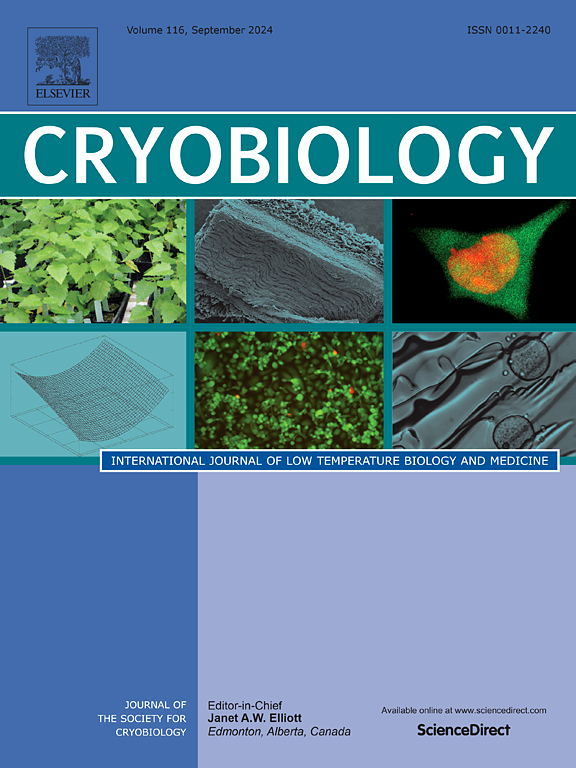55 MHz constant field dielectric warming of kidneys and ovaries cryopreserved by vitrification
IF 2.3
3区 生物学
Q2 BIOLOGY
引用次数: 0
Abstract
Organs cryopreserved by vitrification benefit from fast warming to avoid growth and recrystallization of ice that may nucleate during cooling and during warming. Rapid warming is especially important for tissue that doesn't absorb the full concentration of perfused cryoprotectants. Nanowarming uses an oscillating magnetic field to heat magnetic nanoparticles introduced into blood vessels during cryoprotectant perfusion. Dielectric warming uses an oscillating electric field to directly heat water and cryoprotectant molecules everywhere inside an organ. The efficiency of dielectric warming peaks at a particular solution viscosity and temperature that depends on the field oscillation frequency. Below that temperature, field uniformity is very important for uniform warming. An 800 W 55 MHz dielectric warming system was constructed that reached peak warming efficiency at −60 °C instead of −70 °C previously observed at 27 MHz when using the M22 vitrification solution. The shape of capacitor plates that formed the electric field for organ warming was optimized by computer simulation. Computer simulation also provided insights into the effects of organ container shape on internal field uniformity, confirming the theoretical prediction that ellipsoidal shapes are optimum. Dielectric materials surrounding the organ container during warming were used with beneficial effect. In physical experiments with constant field warming at 55 MHz, warming rates peaked near 200 °C/min for ∼15 g rabbit kidneys in 45 mL total volume, and near 700 °C/min for ∼5 g porcine ovaries in 15 mL total volume. Of three rabbit kidneys vitrified, dielectrically warmed under slightly varying conditions, and then transplanted, one survived long-term with return to normal clinical function (serum creatinine <2 mg/dL) in the recipient animal still living 17 months later. The mass of the kidney was 13.9 g, by an order of magnitude the largest vitrified vital organ successfully returned to clinically normal function to date.

用玻璃化法冷冻保存的肾脏和卵巢的55 MHz恒定场电介质加热
通过玻璃化冷冻保存的器官受益于快速升温,以避免在冷却和升温过程中可能成核的冰的生长和再结晶。快速升温对于不能充分吸收灌注的冷冻保护剂的组织尤为重要。纳米加热利用振荡磁场加热在冷冻保护剂灌注过程中引入血管的磁性纳米颗粒。电介质加热利用振荡电场直接加热器官内各处的水和冷冻保护剂分子。电介质升温的效率在特定的溶液粘度和温度下达到峰值,这取决于场振荡频率。低于该温度,场均匀性对于均匀升温非常重要。构建了一个800 W 55 MHz的介质加热系统,在- 60°C时达到峰值加热效率,而不是之前使用M22玻璃化溶液在27 MHz时观察到的- 70°C。通过计算机模拟优化了形成器官加热电场的电容器板的形状。计算机模拟也为器官容器形状对内部场均匀性的影响提供了见解,证实了椭球形状是最佳的理论预测。在加热过程中,在器官容器周围使用介电材料,效果良好。在55 MHz恒定现场升温的物理实验中,对45 mL总容积的~ 15 g兔肾的升温速率峰值接近200°C/min,对15 mL总容积的~ 5 g猪卵巢的升温速率接近700°C/min。将三只兔肾玻璃化,在稍微不同的条件下电介质加热,然后移植,其中一只长期存活并恢复正常临床功能(血清肌酐2 mg/dL),在17个月后仍然存活。肾脏的质量为13.9 g,是迄今为止最大的玻璃化重要器官成功恢复临床正常功能的数量级。
本文章由计算机程序翻译,如有差异,请以英文原文为准。
求助全文
约1分钟内获得全文
求助全文
来源期刊

Cryobiology
生物-生理学
CiteScore
5.40
自引率
7.40%
发文量
71
审稿时长
56 days
期刊介绍:
Cryobiology: International Journal of Low Temperature Biology and Medicine publishes research articles on all aspects of low temperature biology and medicine.
Research Areas include:
• Cryoprotective additives and their pharmacological actions
• Cryosurgery
• Freeze-drying
• Freezing
• Frost hardiness in plants
• Hibernation
• Hypothermia
• Medical applications of reduced temperature
• Perfusion of organs
• All pertinent methodologies
Cryobiology is the official journal of the Society for Cryobiology.
 求助内容:
求助内容: 应助结果提醒方式:
应助结果提醒方式:


